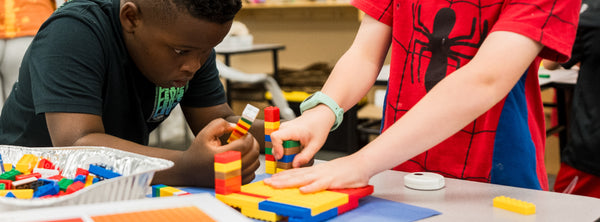
Building Computational Thinking in Young Learners
Can you “debug” this code?

You didn’t need to be an expert in binary code to solve this problem, but you certainly had to think like a computer scientist! You recognized and predicted a sequence all while practicing essential problem-solving and logical thinking skills.
With STEAM, even your youngest learners can excel in computational thinking!
PCS Edventures offers engaging and accessible introductions to computational thinking specifically designed for early education and elementary school learners. Our hands-on programs for grades TK-K and 1-3 adapt fundamental computational thinking skills to meet learners at their level.
Click the images below to learn more about each program.
Grades TK-K
Learners participate in no-tech, game-style activities and participate in interactive play. Through hands-on exploration, they tackle real-world challenges, develop ideas and theories and pursue innovative solutions.
Grades 1-3
As learners become more advanced, they are ready to take on simple robotics and coding. These tech-focused programs are designed to introduce basic programming concepts in a fun and engaging way.
But what exactly is computational thinking and why is it so important? Keep reading for benefits and tips for integrating computational thinking in your early education learning environment.
What is Computational Thinking?
Computational thinking is a problem-solving process that fosters innovation. It emphasizes breaking down complex problems, enabling learners to identify a clear, step-by-step path toward a solution.
There are four components of computational thinking:
- Decomposition – Breaking a complex problem down into smaller more manageable parts.
- Pattern Recognition – Recognizing patterns or trends within a problem.
- Abstraction – Focusing on key information to find the correct solution.
- Algorithms – Developing step-by-step instructions for how to solve a problem.
These components form a problem-solving technique that extends beyond the learning environment. They encourage learners to consider different perspectives and identify relevant information, helping them find solutions in a way that makes sense to them. Best of all, computational thinking develops essential life skills learners can rely on beyond their academic and professional careers.
Integrating Computational Thinking into Early Educational Environments
It's never been easier to facilitate engaging activities that teach basic computational thinking! Our programs’ Educator Guides break down concepts with step-by-step directions providing lessons that follow a clear and predictable outline with plenty of room for expansion.
That’s right! Computational skills are so handy we used all four (decomposition, algorithms, patterns and abstraction) to design our guides! We’ve done all the heavy lifting so you can focus on your learners.
Let’s look at how STEAM instruction incorporates the four components of computational thinking with examples from our exciting early educational programs.
1. Decomposition
Breaking a complex problem into manageable parts is an invaluable life skill. It helps learners focus on the problem at hand, reduces feelings of overwhelm and makes challenges more accessible. The earlier we show learners how it’s done, the more intuitively they’ll apply it to challenges they face, even outside their learning environment.
Grades TK-K
All aboard Transportation: STEAMventures! In an activity that puts the STEAM in steam engine, learners arrange shapes on a blank piece of paper to construct their unique train designs. There are no strict rules or predetermined outcomes, allowing for an open-ended exploration of possibilities. However, learners must think about the typical appearance of a train engine as they design, blending creativity with a touch of logical thinking.

This process gets learners’ imaginations going, making them think about how different shapes fit together. It’s a chance to discuss how tasks can be broken down into their parts, each one playing a key role in creating the big picture.
Grades 1-3
All three of our featured elementary-level programs model just how meticulous computer scientists must be while coding. Whether moving Rockin’ Robots or coding a quiz show in Scratch Camp, learners need to break the final product down by every individual step. A computer is only able to do exactly as it’s told. So, learners quickly see how essential each small part of a code is to their programs' overall success.

2. Pattern Recognition
Noticing patterns is helpful in STEAM learning environments, but its application for young learners has even greater potential. For example, recognizing patterns in their routine adds structure to their day. That stability helps young learners in particular feel safe, giving them more space to focus on learning new skills. It’s one of many ways educators use STEM for SEL Support.
Grades TK-K
In Flight: STEAMventures, learners participate in an exciting relay that introduces pattern recognition. In this hands-on activity, teams practice their communication skills as they race to sort bricks of various sizes.
While a brick sorting sheet is provided for learners to reference, each new round is an opportunity to discuss strategies and improvements for the next. Encourage learners to notice patterns by asking questions such as:
Which brick is the longest and which is the shortest?
Can you spot the brick with the fewest studs?
By sorting bricks based on size, they’ll practice recognizing and categorizing patterns, a fundamental skill in many scientific and mathematical disciplines.
Grades 1-3
Scratch Camp provides a visual and intuitive way to code through blocks. Using commands repeatedly or in combination with others, learners can control the sprite's movement in complex ways.
How do programmers get a character to move across a screen? The "Move 10 Steps Block” activity challenges learners to experiment with moving scratch characters (sprites) in multiple directions.

The more they explore, the more they begin to pick up on different programming patterns. They can soon identify recurring sequences or behaviors and use that knowledge to predict and control future actions.
3. Abstraction
Excessive information can be overwhelming. Abstraction helps by focusing on the most important details. For example, while making macaroni and cheese, a hungry cook doesn't need to understand the science behind how pasta is made. Thankfully, the recipe boils the process down to only the essentials.
Focusing on the big picture without getting bogged down by details allows young learners to become confident problem-solvers.
Grades TK-K
In a fun twist on the classic game Four Corners, Food: STEAMventures gets learners moving and thinking about the four seasons. Our Educator Guide offers several suggestions for clues about summer, spring, winter and fall, each represented in one of the four designated corners. It’s up to learners to listen and focus on the key details that reveal which corner they should run to.
Take a look at this clue:
Fruits like juicy watermelons and plump strawberries begin to ripen under the hot sun.
They’re almost ready to be picked and enjoyed.
Practice the abstraction strategy by inviting learners to pick out the most important information. "Ripe fruit" and "hot sun" are hallmarks of summer. Other details, such as specific fruit types like watermelons and strawberries, provide extra context but aren't essential for determining the season. This activity can help learners concentrate on clue words and phrases, a useful skill for solving math word problems.
Grades 1-3
There are many Cubelets Bot Builder devices, each with unique functions, so build cards play a big role in helping learners find success. A build card is a general road map, outlining key components of a build challenge. It's up to learners to abstract and focus on the function of each piece to meet their goals.

Each card highlights the type of robot, the essential Cubletes and the challenge goal. Teams are encouraged to keep their build cards handy as they work. They serve as a reminder of how valuable a clear outline can be when tackling a challenging problem.
4. Algorithms
Establishing a plan before rushing to find a solution is always a good idea. That can be challenging for many, especially young and excitable learners.
Algorithms are a step-by-step approach that facilitates effective problem-solving. Seeing each step build toward achieving a set goal is incredibly satisfying. Most importantly, it helps learners find a clear path to success.
Grades TK-K
Breaking a task into its most basic parts is a skill we use every day, whether we realize it or not. A preschool student learning to zip up their winter coat has to think through aligning the zipper, pulling the tab upward, wiggling it loose and readjusting any snags—everything is a process!
STEAMventures: Flight gets learners thinking about finding a solution by the sum of its parts. Before rotating through three hands-on station activities, learners practice counting from 1–20 and discuss just how important numbers are in keeping airplanes flying.
One station, the Airplane: Dot-To-Dot challenge, gets learners to gradually connect numbers in sequence to reveal an exciting airplane image. Drawing an airplane freehand might be challenging, but breaking it down into simple, ordered steps captures the essence of computational thinking.
Grades 1-3
Before coding their Rockin’ Robots, learners work together to complete a “Bunnybot Grid Coding Maze” that gets them thinking like computer scientists. For this activity, partners take on the roles of coder and hopper. The coder gives step-by-step instructions that the hopper must follow to reach a carrot at the end of a maze.

Learners need to think carefully about each step. When writing lines of code, clarity is essential because a robot will only do exactly as it is told. This game serves as a fun introduction to using algorithms. It’s an accessible way for learners to experiment before adding technology to the mix. Once robots are introduced in later lessons, they’ll know how important it is to write clear, step-by-step codes.
More Resources to Support Computational Thinking Superstars!
Nurturing computational thinking skills at a young age can prepare learners to thrive in the future. The earlier learners are immersed in STEAM interactive experiences, the easier it will be for them to make computational thinking a part of their natural way of thinking.
Give learners the skills they need to succeed in our world of information overload. Check out these fantastic blogs for more strategies that support learners in their quest to become computational thinking superstars:
- Elevate Math Skills with STEAM
- Coding for Kids: How to Boost Academic Achievement
- Growth vs. Fixed Mindset: How to Create an Engaging Learning Environment
How do you build computational thinking in your young learners?
Tell us in the comments below:

Author: Jessica Ventre
An experienced elementary educator and science instructional coach, Jessica’s passion for STEM instruction and student-led learning is always at the forefront of her lessons and professional development workshops.














